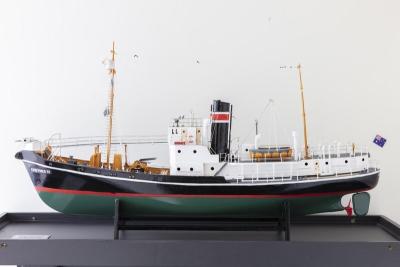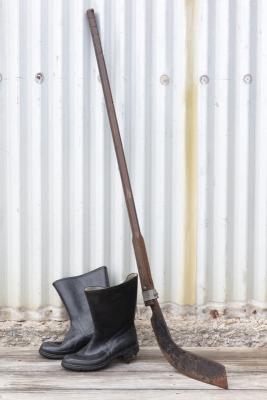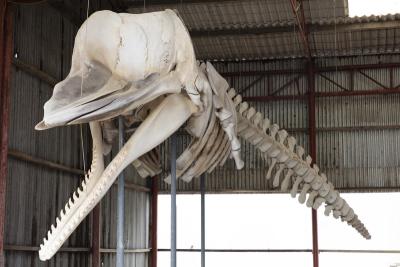PAINTINGS - (a) SOUTHERN ELEPHANT SEAL (b) NORTHERN ELEPHANT SEAL
c. 1985Paintings of (a) Southern Elephant Seal - 2 taupe colored seals, the larger male with large, trunk-like bulbous nose, and red (blood) flecked down mouth & throat (100) (b) Northern Elephant Seal-2 dark brown seals, the larger male with opened mouth, large bulbous nose, and red (blood) flecked throat;
gouache on blue card, framed and mounted with inscription
Collection of 106 of paintings by Richard Ellis that were selected by the Smithsonian Institution to form a traveling exhibit of the marine mammals of the world. The collection was purchased by Perth businessman Kevin Parry in 1985 and donated to Whale World, now known as Albany's Historic Whaling Station.
These prints have been reframed and were originally in a frame with another print (RE.1999.313)
Details
Details
SOUTHERN ELEPHANT SEAL (Mirounga leonina)
Somewhat larger than its northern hemisphere counter-part, the southern elephant seal is found throughout various island groups in the Southern Ocean, including South Georgia, Macquarie, Kerguelen, Heard, Marlon, and the Falklands. They also occur at one mainland location, Peninsula Valdes, on the Patagonian coast of Argentina. At a length of 20 feet, the bulls are the largest of all pinnipeds. Females only get to be about 12 feet long. The nose of this species is smaller than that of the northern variety, and the two species are further differentiated by the extreme flexibility of the southern variety,, which can bend over backwards in a very sharp angle.
100.
NORTHERN ELEPHANT SEAL (Mirounga angustirostris)
Along the coast of California, from San Francisco to Baja, the northern elephant seal "hauls out" to establish breeding colonies in the winter. The huge males fight violently for the control of a harem of females and the calves conceived the previous year. About the turn of the century the population of northern elephant seals had been so reduced by commercial sealers that they were believed to be extinct. The remaining few seals were protected by the Mexican and American government, and have made such a remarkable comeback that there are now believed to be more than 60,000 elephant seals arriving every year on the breeding beaches. After the breeding season, they take to the water to feed; it is suspected that they move north, although no one really knows where they go. For all their ungainliness on land, elephant seals are excellent swimmers and divers.
The paintings represent a body of work by well-known American marine conservationist, author, artist and natural historian Richard Ellis (1938-2024).
Copyright and Reference
Copyright and Reference
Albany's Historic Whaling Station
Albany's Historic Whaling Station
Other items by Richard Ellis
- PAINTING - SOUTHERN BOTTLENOSE WHALE
- PAINTINGS - (a) BAIRD'S BEAKED WHALE (b) GOOSEBEAK WHALE
- PAINTING - BOTTLENOSE DOLPHIN
- PAINTINGS - (a) WEST AFRICAN HUMPBACK DOLPHIN & (b) TUCUXI
- PAINTING - MEDITERRANEAN MONK SEAL
- PAINTING - HEAVISIDE'S DOLPHIN
- PAINTINGS - (a)PYGMY SPERM WHALE (b)DWARF SPERM WHALE
- PAINTINGS - (a) CARIBBEAN MONK SEAL (b) HAWAIIAN MONK SEAL
- PAINTINGS - (a) RIGHT WHALE & (b) BOWHEAD WHALE
- PAINTING - CHINESE RIVER DOLPHIN
- PAINTING - DALL PORPOISE
- PAINTING - (a) INDO-PACIFIC HUMPBACK DOLPHIN & (b) ROUGH-TOOTHED DOLPHIN



